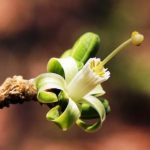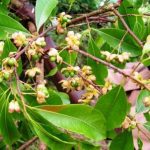TREE LIFE
November 1985
INCREASE IN SUBSCRIPTIONS FOR 1986 TO $10 FOR SINGLE OR FAMILY MEMBERSHIP
Having held off an increase for as long as possible, it now becomes inevitable, and so the committee has decided:
- To remove the difference between single and family membership, as the effective cost to the society is equal
- To raise the annual subscription to a rate of $10 per year
- To investigate changing the society calendar so that it runs from April to March, this would effectively ease the blow as 1986 subscriptions would cover 15 months instead of 12. This also eases the December/January cash-slow crisis
It would be appreciated if members could pay subs as soon as possible as this will greatly assist the treasurer.
MASHONALAND CALENDAR
Tuesday November 5th: Botanic Garden Walk
Sunday November 17th: Entre Rios, Bromley; Chris and Ros Carter have kindly invited us to wander in the hills on their farm. Here enormous granite boulders are scattered throughout a woodland of stately trees. Ros’ aloe garden well deserves a lunchtime stroll and the journey out, on excellent roads, crosses almost pure stands of either Uapaca or Syzygium or Parinari. See if you can detect the reason for these changes. We will share transport once again, so please meet at the Monomatapa Car Park at 0815 to leave at 0830 hours. A security guard will look after the cars left behind.
MATABELELAND CALENDAR
Sunday November 3rd: Hillside Dams. Meet at the end of Sable Road, in the Upper Dam Car Park at 0830 hours.
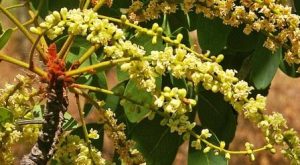
Burkea africana. Photo: Meg Coates Palgrave. Source: Flora of Zimbabwe
NOTES : On Sunday October 6th we went to the Matopos, first to the Mtsheleli Valley to see the msasas. We were about two weeks too late for the bulk flush of the new leaf, but individual trees and groups obliged, so it was well worthwhile. Then we took the “Honeyguide Highway” towards Maleme, and finally lunched below Efifi. The weather was kind, and a fresh wind blew away the Mopani flies. We identified some 55 trees along the route, a good few being in flower. We saw Acacia robusta, some in flower still, on the way in. Albizia amara and A. tanganyicensis were flowering quite spectacularly, and the latter showed so little brown paper on the bark that the bole seemed pearly grey. Azanza garckeana, Boscia angustifolia, which puzzled us a bit; Brachylaena rotundata; Brachystegia spiciformis, some in flower; Burkea africana flowering; Cassia abbreviata, flowering very notably, most in very full flower, and there were many more than we realized, once we even drove through a flowering Cassia arch; what I think was Cassine aethiopica; C. matabelica; Commiphora marlothii and C. mollis; a fine Cussonia natalensis, which served a new function as a cork expeller at lunch; Dodonea viscosa, in flower and seed; Dombeya rotundifolia, flowers mostly bronzed, but a few still white; Euclea divinorum; E. natalensis; E. racemosa; Euphorbia ingens and E. cooperi for contrast; Figs – Ficus sur, Ficus ingens in full new bronzed leaf; F. glumosa; F. thonningii; Heteropyxis dehniae; Maerua juncea, in large flowering shrubs; Maytenus senegalensis and M. undata; Mimusops zeyheri; Olea europea subsp. africana; Ozoroa insignis subsp. reticulata; Pappea capensis with a very clean bole and very few dry leaves; Protea gaguedi flowering; Pterocarpus angolensis in flower; Tarenna neurophylla and Tarenna zimbabwensis near to each other for contrast; a lot of Strychnos matopensis; Vernonia colorata and Ziziphus mucronata. We also had a couple of problem trees, not yet sorted out. However, for these dry times, a very good day.
-C. Sykes
BOTANIC GARDEN WALK: 1ST OCTOBER 1985
MELIACEAE and SIMAROUBACEAE : With the help of Tom Muller we ventured back into the Sapindales, an order we have learned to associate with large and generally pinnately compound leaves. We have already considered the SAPINDACEAE, Tree Life 42, ANACARDACEAE, Tree Life 44 and RUTACEAE, Tree Life 56, but the order also includes the MILIANTHACEAE, BURSERACEAE, MELIACEAE and SIMAROUBACEAE. These families often produce resinous compounds, remember the aromatic citrus oils, the resins of Rhus and Myrrh of Commiphora. We have not yet used smell tests on the MELIACEAE, but it may prove interesting as they too have “resinous secretary cells containing ethereal oils in the leaves”. I missed the beginning of the walk but arrived to find the party admiring Tom’s Khaya nyasica with new red leaves. These fast-growing trees are seen in many local gardens and are usually available from the Forest Nursery. The timber is hard and although Coates Palgrave states it “resists borers and termites”, Tom’s living specimens seem susceptible to borer attack. As with most MELIACEAE the leaves are alternate, often clustered at the ends and are paripinnate, but this is not a constant feature within the family. Some may remember the confusion at Binga Swamp Forest when I proudly presented a dozen seedlings I had pulled up thinking they were the exotic Toona ciliata only to be shown that they all had an odd terminal leaflet. The key to the MELIACEAE states Toons is even, so we thought these could only be seedlings of Ekebergia capensis. We only know of one E. capensis in the forest and as these trees are reportedly either male or female, the seedlings were rare indeed. The embarrassment was overcome later in the week when we discovered that all Toona seedlings are imparipinnate, the tree changes later.
We examined the Ekebergia capensis which grows beneath Tom’s Khaya and found the typical MELIACEAE flowers. Within the petals the stamens, or non-functional stamens in the case of female trees, are fused into a tube. In E. capensis the flower is small and white, but in the Persian lilac, Melia azedarach, this central column is deep purple. A number of MELIACEAE flowers have a heavy scent. In September the Melia on campus become sickeningly sweet whereas the Trichilia emetica at Mana Pools are equally heady. E. capensis grows in forest and along streams at medium altitudes although the other species, E. benguelensis, grows naturally in the Botanic Gardens. For some reason when E. capensis is planted around Harare it is very susceptible to mildew attack and often looks sickly. The E. benguelensis was in full flower and Tom reports they produce tasty red fruit although he had not seen the birds eating them. It is a fact that many local school children eat Melia fruit and survive although these are reportedly “very poisonous”. Some conflicting reports are apparently due to the state of the fruit when eaten, if the tannin content is high it binds with the toxins, but when tannin levels are low the victim dies. Shona and Drummond report killing a 100lb pig in 3.5 hours with only 3 oz of dried leaves..
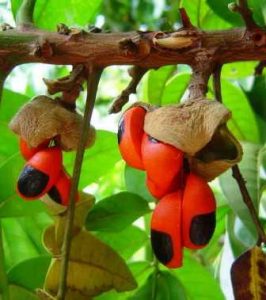
Trichilia dregeana. Photo: Bart Wursten. Source: Flora of Zimbabwe
On the lawns in front of the Khaya we saw Trichilia dregeana from the eastern highland forests. This species is similar to T. emetica which is more widespread growing along the Zambezi River. We really do have difficulty telling these two species apart, especially in people’s gardens. T. emetica’s fruit apparently has a distinct neck connecting it to the stalk and this is absent in T. dregeana, I have not tested this personally as the flowers were still too young. We examined the T. emetica alongside the Ficus chirendensis. Heading into the forest just to the left of the Chrysophyllum Tom showed us Lovea swynnertonii which grows to 58 to 60m in Chirinda Forest, and may have enormous buttresses.
The final tree, which we examined, in this group was Kirkia acuminata, of the related family SIMAROUBACEAE. Other members in this family are characterized by a very bitter bark, wood and seeds and produce chemicals called simaroubalides. It would be interesting to know whether these properties help to protect it from elephant damage, as they do grow in most elephant areas. Decoctions of the bark of various American genera have been used as anti malarial, although a similar use is not reported from Africa. We still need to examine the few simple leaved members of the MELIACEAE belonging to the genus Turrea.
On the walk we also examined the genus Ziziphus of the RHAMNACEAE and Galpinia of the LYTHRACEAE – these will be included as root notes when space is available. We really must thank Tom once again for an informative walk.
Kim ST.J.Damstra
HIDDEN VALLEY : SUNDAY 20TH OCTOBER 1985
This month we visited the charming and aptly named Hidden Valley, kindly hosted by the Morleys who, although away on holiday, nevertheless let us invade their farm and house where we were well attended by their willing domestic worker.
Having reached our valley destination, we split into three groups. Our group commenced by admiring a large, spreading and shady Erythrina. The broad leaflets of the trifoliolate leaves and the large woody pods led me to conclude that this was E. abyssinica. Around this giant were a few Ficus sycamorus some with green fruit on the main branches. The yellow green trunk was compared minutes later with the plain grey smooth trunk of F. thonningii. One individual of the latter species had run its aerial roots down like candle wax in attractive fashion. This fig bears the pea sized fig at the ends of the branches in amongst the leaves. We also saw F. sur in fruit and noted how the figs grow from the main trunk. Many of the smaller specimens were at a stage where they were confused with Maesa lanceolata due to the similar leaf shape
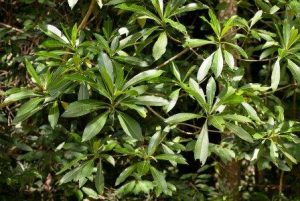
Rauvolfia caffra. Photo: Bart Wursten. Source: Flora of Zimbabwe
I suppose the most spectacular constituent of this riverine habitat was Rauvolfia caffra. The long glossy leaves with a white midrib were most attractive. This is a member of the APOCYANACEAE and produces a milky sap. This species has the leaves coming out in whorl of four from the stem.
Celtis africana was in full leaf. The asymmetric leaf can at first glance be confused with that of Ziziphus mucronata which we also inspected. However the serrations of Celtis are distinct, extending about 2/3rds of the way round from the apex to the base. Ziziphus is without these serrations but has its own distinctive feature – the one curved and one straight thorn.
Of the other main components of the canopy the most prominent were Albizia amara the tree with very fine leaflets which looks a good deal like an Acacia but has no thorns, and Acacia sieberiana and A. polyacantha, the former having straight thorns and round flowers and the latter with hook thorns and spike flowers. Later in the morning we were able to apply the same test to A. goetzei and A. amythethophylla.
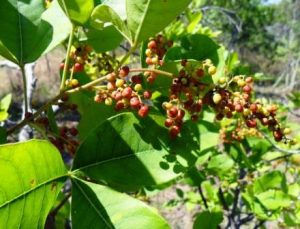
Rhus longipes. Photo: Bill Clarke. Source: Flora of Zimbabwe
Syzygium cordatum was still in flower, resembling the flower of eucalyptus and in the under-storey Rhus longipes was heavy with ripe tasty fruit. This is one of our trifoliolate leafed trees. This has the Rhus smell when the leaf is crushed, and the leaf is relatively smooth with the margin entire. The roundish shape also helps to set this apart from some of the others. We later saw Rhus lancea, quite different with long thin leaflets. The other trifoliolate tree seen, and an unusually large specimen, was Allophylus africanus. This has a scalloped margin and a slightly velvety feel. Usually it also has “hairy armpits” in the axils of the veins and mid rib.
Maytenus heterophylla was in new bright green leaf. The specific name was well demonstrated on one specimen where the leaves were sometimes fascicled; other times alternate and different sizes. Also present was Maytenus senegalensis distinct with blue grey green leaves and pink petioles. Most extraordinary was the regeneration from suckers or lateral roots over a wide area.
The under-storey was full of Vernonia subuligera seeding liberally. This is one Vernonia I do recognize, because of the large stipules at the base of the petioles on the steam.
Both Cassia singueana and C. abbreviata were present at the edge of the riverine thicket, C. singueana with small fleshy yellow pods and C. abbreviata with last year’s long straight brown pods. Flowers were present on some of both species allowing us to compare the lemon yellow of C. abbreviata and the egg-yolk yellow of C. singueana. The acid test in the absence of flowers or pods is the presence of glandular “bee stings” on the rachis between the leaflets of C. singueana. Speaking of pods, pods from Bauhinia thonningii, the monkey bread, were collected. We found that they make such popular rattles our girls were soon fighting over them!
Two Combretums were seen C. erythrophyllum in new leaf was well endowed with the cat or “leopard claw” marks on the trunk, which are such a useful aid to identification. C. molle was in full flower and new leaf. The silky velvety golden leaves are almost tempting to eat. Some of last year’s four winged fruit were present as an aide-memoire.
Dovyalis zeyheri was present in the under storey, again with glossy, fresh green leaves, but not helping identification as they did not have the usual spiny thorns and “race track” leaf miner. Diospyros lycioides was in flower. Pittosporum viridiflorum gave itself away by the dark lenticels on the bark and the typically distorted or deformed leaves. The crushed leaves have a resinous fragrance. Securinega virosa was widespread but without the small white fruit giving it the name snowberry.
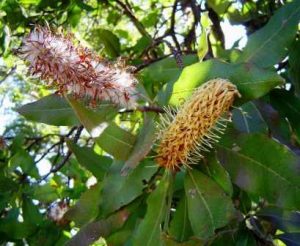
Faurea speciosa. Photo: Bart Wursten. Source: Flora of Zimbabwe
On the outer edge of the riverine thicket Faurea speciosa in flower. This tree belongs to the PROTEACEAE and the flower head looks like a “stretched out” Protea flower head. A useful identification is the marginal vein going all the way around the edge of the leaf. This applies also to F. saligna, the narrow leafed Faurea which we also saw in the afternoon. Saligna is a word likening this tree to the willow Salix and as a visual aid we encountered two vagrant, invading, specimens of the exotic S. babylonica in the Valley forest. At lunchtime the motorcade trundled back to the house for lunch in a refreshingly colourful garden beneath a spreading Brachystegia boehmii. Straight after lunch the magnificent old Afzelia quanzensis on the far side of the house, in leaf, pod and flower allowed Kim to conduct a botany practical in the field and he will explain what it was all about. Many thanks to the Morleys, as well as the new owner, for an excellent venue.
-J.P. Haxen
The large pod mahogany, Afzelia quanzensis on the lawns provided much interest at lunchtime. The books state that the flower has one petal, 2 staminodes, sterile anthers, and 7 stamens. Well, in 62 flowers we found a total of 14 staminodes that had developed a structure remarkably similar to the petal. This is a petaloid staminode and often occurs in highly cultivated flowers. In carnations all the coloured bits are really staminodes, the petals are the green sheath around them which often splits down one side and so florists often wire them up. In view of these petaloid staminodes we considered whether it may be possible that the ‘petal’ represents a staminode and not a true petal. This would mean that 7 = 2 – 1 would equal 10 male parts – a common number in legumes. Closer examination revealed a very reduced and stubby petal, and this seems to match the 4 sepals. The idea was partly confused by some flowers which had a third staminode just in front of the petal, so we are not sure of the idea at all and await a friendly reply from the boffins.
In the afternoon we headed up the hillside to hunt for two rare Ochna species. The first O. gambleoides, has very large leaves and we have seen it twice on our outings, once at the Duffield’s Farm in Raffingora, and once Edone Petheram found it on the Foot’s Farm, not too far from Hidden Valley. We did not find it. Secondly we hunted for O. cyanophylla, a species none of us had ever seen, that we know of. It apparently resembles O. schweinfurthiana except that it has 6 – 8 carpels, whereas O. schweinfurthiana has only 5, and the leaves are blue green, or at least turn blue green when pressed. It has been collected near Mazowe Dam Wall, near Saffron Walden, as well as Nyanga and Masvingo, so looking at hidden Valley is not too far out. We don’t think we found it but are giving the pressed specimens sometime to mature.
-Kim ST.J. Damstra.
ROOTNOTE : We have bad news for everyone who thought they saw Chlorophora excelsa and Cardiogyne africana down in Gonarezhou, they did not. I have just heard from Dr. Berg in Utrecht that he changed these names some time ago, so that we now have Milicia excelsa and Maclura africana. The good news was that he says we can publish a rough key to the figs which he has been working on. I still need to take out all the Central African species but we will put it in the newsletter when completed.
-Kim ST.J.Damstra
The LYTHRACEAE. The last tree which we examined on the October Botanic Garden Walk was Galpinia transvaalica which Tom has growing near to the St. George’s School fence in the S.E Lowveld section. This species only comes into the country in the S.E. Lowveld and Tom collected this specimen from the Mateke Hills and now he finds they grow like a weed. The LYTHRACEAE to which Galpinia belongs, also contains the Pride of India and it fits into the order Myrtales. We looked at other members of the Myrtales in July, Tree Life 66, when we examined the MYRTACEAE and OLINIACEAE as well as the THYMELAEACEAE, although there is much discussion and disagreement as to whether the THYMELAEACEAE really do belong here or not. As with most of the Myrtales, the leaves of Galpinia are simple, entire and opposite, although we found a number in whorls of 3. They also have a sub marginal vein which we noted in Syzygium, Olinia and Heteropyxis. We did not look for the “conspicuous gland which terminates the mid rib before it reaches the apex” mentioned in Coates Palgrave, so a re-examination may be well worthwhile. The yellow flowers are apparently most attractive but, we only saw the tiny fruit capsules which remain on the branches. One of the most memorable features about the LYTHRACEAE are the dyes which are produced from members of this family. The dried leaves of Lawsonia inermis are used to make henna. The leaves of Woodfordia fruticosa yield a red colour and the bark and wood of some Lafoensia give a yellow dye, Heywood, 1978. It may be worth seeing if Galpinia has potential.
-Kim ST.J. Damstra
The RHAMNACEAE. In this month’s Botanic Garden Walk we also began with the RHAMNACEAE, a family that belongs to the order Rhamnales which also contains the grape family VITACEAE. This follows on from last month’s walk, as they do show some affinity to the Celastrales, Tree Life No. 68. Having noted the dyes which come from the LYTHRACEAE, it is worth noting that many dies also come from the RHAMNACEAE; the berries of Rhamnus cathartica yield the pigment sap green; R. infectoria berries provide a yellow pigment; and Chinese green indigo comes from the bark of R. chlorophora. Many RHAMNACEAE have quinines in the bark and are used in local medicine. The ancient lotus fruit of Greek legends is believed to be that of Ziziphus lotus and were supposed to induce luxurious dreaminess and a distaste for active life. The Greeks were not wrong at all if Z. mauritiana is anything to go by, although around Harare the dreaminess is assisted by distillation of the fermented berry to make to potent drink kachaso. Enormous piles of fruit, masawa, are brought into Mbare Musika Market in August and September and fill the crowded stalls and narrow alleyways with a heavy honey scent. These fruits are generally collected from the Zambezi Valley where this species, thought to be introduced, may grow in solid stands. Here the ground beneath the trees is swept clean assisting collecting. But the fruit are refreshing eaten on their own, and the seedlings have been scattered along many road sides and sanitary lanes. The RHAMNACEAE have simple, alternate leaves which are pinnate or pinnipalmate, with several main veins from the base. The small leaves of Z. mauritiana have a symmetrical base and the characteristic paired spines occur along the branch, with one straight and one hooked. Near the Kirkia we saw a spreading Z. abyssinica from the Zambezi Escarpment. This is similar to our local Z. mucronata with its large asymmetric leaf base and paired spines, except that in Z. abyssinica the under surface is much more densely pubescent, like soft velvet. The top is a shiny green. There are two subspecies of Z. mucronata, around Harare we see subsp. rhodesica with a wooly under surface whereas in the south of Zimbabwe subsp. mucronata is more glabrous. Tom showed us this more riverine form on the way to the S.E. Lowveld section. The last indigenous species that forms a tree is Z. pubescence which Tom has growing between a Ficus ingens and Citropsis, alongside a Schotea that was in full flower. This forms a shrubby tree in the S.E. Lowveld and is unarmed.
-Kim ST.J. Damstra
KIM DAMSTRA Acting Chairman


